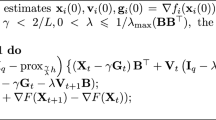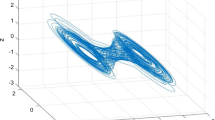Abstract
In this paper, sampled-data based average-consensus control is considered for networks consisting of continuous-time first-order integrator agents in a noisy distributed communication environment. The impact of the sampling size and the number of network nodes on the system performances is analyzed. The control input of each agent can only use information measured at the sampling instants from its neighborhood rather than the complete continuous process, and the measurements of its neighbors’ states are corrupted by random noises. By probability limit theory and the property of graph Laplacian matrix, it is shown that for a connected network, the static mean square error between the individual state and the average of the initial states of all agents can be made arbitrarily small, provided the sampling size is sufficiently small. Furthermore, by properly choosing the consensus gains, almost sure consensus can be achieved. It is worth pointing out that an uncertainty principle of Gaussian networks is obtained, which implies that in the case of white Gaussian noises, no matter what the sampling size is, the product of the steady-state and transient performance indices is always equal to or larger than a constant depending on the noise intensity, network topology and the number of network nodes.
Similar content being viewed by others
References
Gazi V, Passino K M. Stability analysis of swarms. IEEE Trans Autom Control, 2003, 48(4): 692–696
Olfati-Saber R. Flocking for multi-agent dynamic systems: algorithms and theory. IEEE Trans Autom Control, 2006, 51(3): 401–420
Fax J A, Murray R M. Information flow and cooperative control of vehicle formations. IEEE Trans Autom Control, 2004, 49(9): 1465–1476
Lynch N. Distributed Algorithms. San Matero, CA: Morgan Kaufmann, 1996
Olfati-Saber R. Distributed Kalman filter with embedded consensus filters. In: Proceedings of the 44th IEEE Conference on Decision and Control, and the European Control Conference 2005, Seville, Spain, 2005. 8179–8184
Olfati-Saber R, Shamma J S. Consensus filters for sensor networks and distributed sensor fusion. In: Proceedings of the 44th IEEE Conference on Decision and Control, and the European Control Conference 2005, Seville, Spain, 2005. 6698–6703
Vicsek T, Czirok A, Jacob E B, et al. Novel type of phase transitions in a system of self-driven particles. Phys Rev Lett, 1995, 75(6): 1226–1229
Conradt L, Roper T J. Consensus decision making in animals. Trends Ecol Evol, 2005, 20(8): 449–456
Hoogendoorn S P. Pedestrian flow modeling by adaptive control. Transport Res Rec, 2004, 1878: 95–103
Barahona M, Pecora L M. Synchronization in small-world systems. Phys Rev Lett, 2002, 89(5): 054101
Jadbabaie A, Lin J, Morse A S. Coordination of groups of mobile autonomous agents using nearest neighbor rules. IEEE Trans Autom Control, 2003, 48(6): 988–1001
Liu Z, Guo L, Connectivity and synchronization of Vicsek model. Sci China Ser F-Inf Sci, 2008, 51(7): 848–858
Ren W, Beard R W. Consensus seeking in multiagent systems under dynamically changing interaction topologies. IEEE Trans Autom Control, 2005, 50(5): 655–661
Wang L, Guo L. Robust consensus and soft control of multiagent systems with noises. J Syst Sci Complex, 2008, 21(3): 406–415
Olfati-Saber R, Murray R M. Consensus problem in networks of agents with switching topology and time-delays. IEEE Trans Autom Control, 2004, 49(9): 1520–1533
Kingston D B, Beard R W. Discrete-time average-consensus under switching network topologies. In: Proceedings of the 2006 American Control Conference, Minneapolis, Minnesota, USA, 2006. 3551–3556
Xie G M, Wang L. Consensus control for a class of networks of dynamic agents: fixed topology. In: Proceedings of the 44th IEEE Conference on Decision and Control, and the European Control Conference 2005, Seville, Spain, 2005. 96–101
Xie G M, Wang L. Consensus control for a class of networks of dynamic agents: switching topology. In: Proceedings of the 2006 American Control Conference, Minneapolis, Minnesota, 006. 1382–1387
Wang J H, Cheng D Z, Hu X M. Consensus of multi-agent linear dynamic systems. Asian J Control, 2007, 10(2): 144–155
Hong Y G, Hu J P, Gao L X. Tracking control for multi-agent consensus with an active leader and variable topology. Automatica, 2006, 42(7): 1177–1182
Moreau L. Stability of multiagent systems with time-dependent commmunication links. IEEE Trans Autom Control, 2005, 50(2): 169–182
Bauso D, Giarré L, Pesenti R. Non-linear protocols for optimal distributed consensus in networks of dynamics agents. Sys Control Lett, 2006, 55(11): 918–928
Cao M, Morse A S, Anderson B D O. Reaching a consensus in a dynamically changing environment-convergence rates, measurement delays and asynchronous events. SIAM J Control Optim, 2006, 47(2): 601–623
Hatano Y, Mesbahi M. Agreement over random network. IEEE Trans Autom Control, 2005, 50(11): 1867–1872
Wu C W. Synchronization and convergence of linear dynamics in random directed networks. IEEE Trans Autom Control, 2006, 51(7): 1207–1210
Olfati-Saber R, Fax J A, Murray R M. Consensus and cooperation in networked multi-agent systems. Proc IEEE, 2007, 95(1): 215–233
Ren W, Beard R W, Atkins E M. A survey of consensus problems in multi-agent coordination. In: Proceedings of the 2005 American Control Conference, Portland, OR, USA, 2005. 1859–1864
Kingston D B, Ren W, Beard R W. Consensus algorithm are input-to-state stable. In: Proceedings of the 2005 American Control Conferences, Portland, OR, USA, 2005. 1686–1690
Ren W, Beard R W, Kingston D B. Multi-agent Kalman consensus with relative uncertainty. In: Proceedings of the 2005 American Control Conferences, Portland, OR, USA, 2005. 1865–1870
Huang M, Manton J H. Coordination and consensus of networked agents with noisy measurement: stochastic algorithms and asymptotic behavior. SIAM J Control Optim, 2009, 48(1): 134–161
Li T, Zhang J F. Mean square average consensus under measurement noises and fixed topologies: necessary and sufficient conditions. Automatica, 2009, 45(8): 1929–1936
Yao L L, Zhang J F. Sampled-data-based LQ control of stochastic linear continuous-time systems. Sci China Ser FInf Sci, 2002, 45(5): 383–396
Åström K J, Wittenmark B. Computer-Controlled Systems: Thoery and Design, 3rd Ed. Englewood Cliffs, NJ: Prentice Hall, 1997
Godsil C, Royle G. Algebraic Graph Theory. New York: Springer-Verlag, 2001
Xiao L, Boyd S. Fast linear iterations for distributed averaging. Syst Control Lett, 2004, 53(1): 65–78
Bruckstein A M, Cohen N, Efrat A. Ants, crickets and frogs in cyclic pursuit. In: Center for intelligent systems Technical Report 9105, Technion-Israel Institute of Technology, Haifa, Israel, 1991
Wolfowitz J. Products of indecomposable, aperiodic, stochastic matrices. Proc Amer Math Soc, 1963, 14: 733–736
Teicher H. Almost certain convergence in double arrays. Z Wahrsch Verw Gebiete, 1985, 69(3): 331–345
Chow Y S, Teicher H. Probability Theory: Independence, Interchangeability, Martingales, 3rd ed. New York: Springer-Verlag, 1997
Author information
Authors and Affiliations
Corresponding author
Additional information
Supported by Singapore Millennium Foundation and the National Natural Science Foundation of China (Grant Nos. 60821091, 60674308)
Rights and permissions
About this article
Cite this article
Li, T., Zhang, J. Sampled-data based average consensus with measurement noises: convergence analysis and uncertainty principle. Sci. China Ser. F-Inf. Sci. 52, 2089–2103 (2009). https://doi.org/10.1007/s11432-009-0177-7
Received:
Accepted:
Published:
Issue Date:
DOI: https://doi.org/10.1007/s11432-009-0177-7




